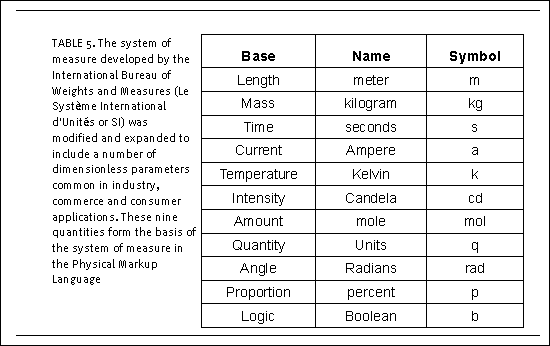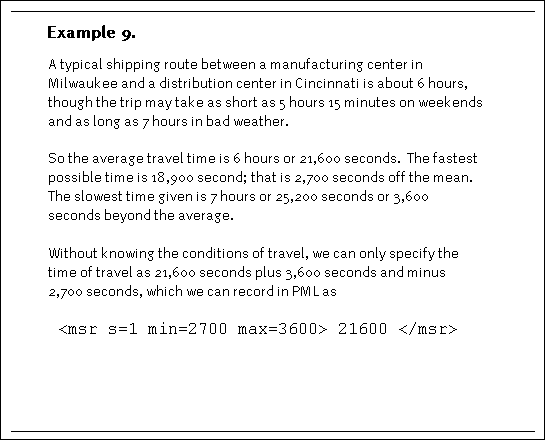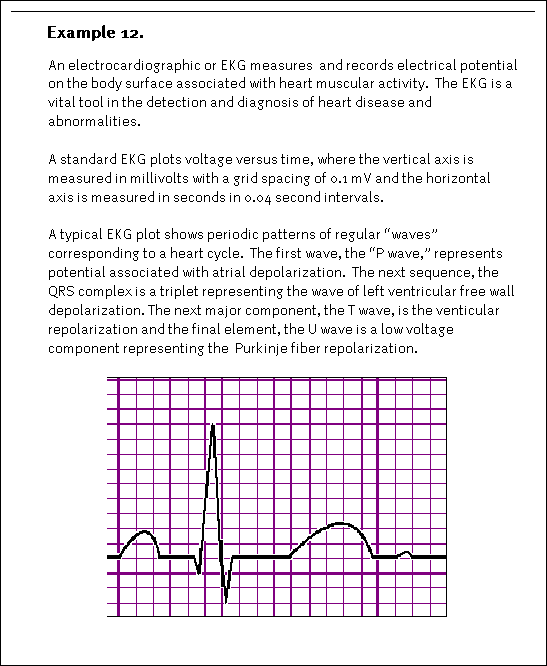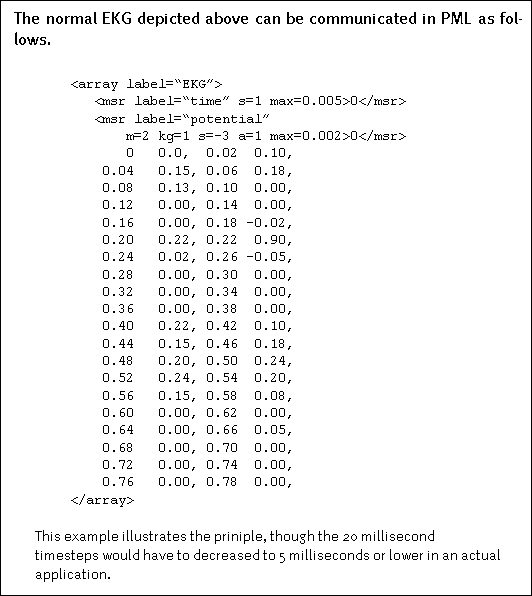Measure
Physical
states of matter have always been compared with known
references. From cubits
to nanometers from stones
to dekagrams, multiples
of common quantities provide the means for communicating
physical properties.
Rather
than adopt a panoply of measurement
systems, the Physical Markup Language relays on a
single one, and then uses the computer network and
processing power to accurate translate and communicate
actual and intended data into the target measurement
system. The reliance on a single standard removes
ambiguity, simplifies data communication and facilities
uniform presentation among disparate systems.
Units
PML
will drive its units from the fundamental units
of measure developed by the International
Bureau of Weights and Measures (Le
Système International d'Unités or
SI) in conjunction with
others such as the National
Institute of Standards and Technology (NIST)
in the United Sates.
Although
the SI units form the basis, the PML specification
modifies and expands those to accommodate the particular
needs of industry, commerce and consumer applications.
In particular quantity
(dimensionless measure of units),
angle (dimensionless measure of angle in radians)
and percent were added
to facility the communication of common dimensionless
values.
The
eleven units forming the basis of the PML measurement
specification are shown below in See The system
of measure developed by the International Bureau
of Weights and Measures (Le Système International
d'Unités or SI) was modified and expanded
to include a number of dimensionless parameters
common in industry, commerce and consumer applications.
These nine quantities form the basis of the system
of measure in the Physical Markup Language.

Most
physical properties will be products of these base
units. Speed, for example,
is the ratio of length to time, viscosity
may be defined in kilograms per meter seconds and
power kg m2 s-3.
PML
defines a measure element, msr
, which contains a single floating-point number.
The msr
element includes nine
optional attributes m,
kg, s, a, K, cd, mol, q, rad,
p and b
which define the exponent of the unit of measure.
If an exponent attribute is omitted it is assumed
to be zero.
The
two quantities just mention, speed, for example,
would be written as
<msr m=1 s=-1> and viscosity would
be <msr
kg=1 m=2 s=-3> . The advantage is that
unit conversion and measurement ambiguity are eliminate.
Accuracy
Measurements,
of course, are not always accurate. Using a ruler
you can measure to within 0.1 of an inch, with a
caliper to within 0.001 in and with a micrometer
to within 0.0002. We need some means of specifying
accuracy within the measurement specification of
the Physical Markup Language.
There
are many ways to specify tolerances. Again keeping
with our philosophy of one simple, yet usable specification,
this version of PML uses a just a minimum and maximum
tolerance.
Therefore
we introduce attributes into the msr
element: a tolerance
specification min
and max
, representing the minimum and maximum tolerance
of the measurement.
<msr min= float max= float > float </msr>
In
other words, the actual value lies somewhere between
the specified value less the min value and the specified
value plus the max.
If
the attributed min is missing, the actual value
is interpreted to lie within the specified measurement
plus or minus the max value.
<msr max= float > float <msr>


We
include in the measurement specification a simple
label
attribute containing
a string, which simply describes the type of measurement,
such as "ambient temperature" or "nominal
weight"
<msr
label= string
> float
</msr>
Intention
Often
we want to specify a measurement concept, such as
1 foot - exactly one
foot not 0.3048 meters. We may want those with whom
we communicate to understand a measurement concept
- such as "one foot." If we translate
into a common standard, how can we be assured this
concept will be preserved during the communication?
Fortunately
there is enough information in the PML definition
to convey this intent. We can use the tolerance
together with a flag signaling the receiver to "latch"
a data value to the nearest increment within the
bounds of the tolerance - in other words, to round
to the nearest unit.
For
example, suppose we convert the intention of 1 foot
to the PML specification of 0.3048 meters. If we
include a tolerance of say 0.001 meters (or one
millimeter) together with flag indicating the receiver
should "latch" to the nearest unit, then
a conversion to Imperial units would yield 12 inches
or 1 foot - exactly.
To
communicate this intent, we introduce a latch
attribute, which accepts
a Boolean value of either "true" or "false".
<msr
latch= boolean > float
</msr>
Arrays
Multiple
data values - even streaming telemetry
- can be communicated efficiently with the array
element.
The
array
element includes one or more msr
elements. The number msr
elements defines the dimension of the array, the
attributes of the individual elements define the
units and range of each dimension, and the value
of the msr
element is the offset of initial condition of the
data values. We also include a label
attribute describing the array.
Following
the msr
elements are a list of float point vectors.
These vectors are denoted by a list of floating
point numbers separated by spaces, and the vectors
themselves separated by commas. The dimension of
the vectors must match the number of msr
elements.
<array
label=string
>
<msr
label=string
> float
</msr> (Dim
1)
. . . . . .
<msr
label=string
> float
</msr>
(Dim n)
float1
float2 . . . floatn ,
float1 float2 . . . floatn
,
. . .
float1
float2 . . . floatn
</array>


The
array
element provides another method for recording data.
The optional attribute periodic
allows measurements with respect to regular, periodic
input. The periodic
attribute accepts a
single integer representing the number of
independent variables.
If
periodic
is set to 1, for example, the array
element assumes measurements with respect to a single
independent variable. If periodic
is set to 2, measurements are assumed to be with
respect to two indendent variables - a grid or surface
map are good examples.
The
array
element allows an arbitrary number of
dependent variables for every measurement.
In other words, for every independent data value,
there may be one or more output values .
Since
the array
element allows one or more periodic input variables,
the specification must record the offset and frequency
of these variables, as well as the number of measurements
along each dimension.
Following
the array
declaration, there are pairs of msr
elements representing the initial value and period
of each independent dimension. There is also a
size element,
which simply storages an integer representing the
number of measurements along that dimension. Thus
if the periodic
attribute is set to m
, there will be m pairs
of msr
elements and m
size elemnts as follows
<array
label=string
periodic=integer
>
<msr> float
</msr> (offset
1)
<msr> float
</msr> (period
1)
<size> integer
</size> (size
1)
. . .
<msr> float
</msr> (offset
m)
<msr> float
</msr> (period
m)
<size> integer
</size> (size
m)
Following
the specification of the independent variables,
the array
element expects one or more msr
elements representing the number and offsets of
the dependent variables.
<array
label=string
periodic=
integer >
<msr> float
</msr>
(offset 1)
<msr> float
</msr>
(period 1)
<size> integer
</size> (size
1)
. . .
<msr> float
</msr> (offset
m)
<msr> float
</msr> (period
m)
<size> integer
</size> (size
m)
<msr> float
</msr> (dimension
1)
. . .
<msr> float
</msr> (dimension
n)
The
data is stored in vectors. The vectors are separated
by commas and their component values are separated
by white space. Assuming there are
m independent variables and
ki elements for the i
th indenpendent variable, there will be
n -dimensional vectors. The general form of
the array element is as follows:
<array
label= string periodic=
integer >
<msr> float </msr>
(offset 1)
<msr> float </msr>
(period 1)
<size> integer </size>
(size 1)
. . .
<msr> float </msr>
(offset m)
<msr> float </msr>
(period m)
<size> integer </size>
(size m)
<msr> float </msr>
(dimension 1)
. . .
<msr> float </msr>
(dimension n)
float1
float2 . . . floatn ,
float1 float2 . . . floatn
,
. . .
float1
float2 . . . floatn
</array>
Units
The
following table illustrates some of the commonly
used units and their representation in the Physical
Markup Language.
|
Quantity |
Name |
Symbol |
PML
Units |
|
Area |
square
meter |
|
m=2 |
|
Volume |
cubic
meter |
|
m=3 |
|
Speed |
meter/second |
|
m=2 s=-1 |
|
Accelearation |
meter/second2 |
|
m=2 s=-2 |
|
Mass
density |
kilogram/meter3 |

|
kg=1 m=-3 |
|
Specific
volume |
meter3/kilogram |
|
kg=1 m=-3 |
|
Current
density |
Ampere/meter2 |
|
a=1 m=-2 |
|
Magnetic
field strength |
Ampere/meter |
|
a=1 m=-1 |
|
Concentration |
moles/meter3 |
|
mol=1 m=-3 |
|
Luminance |
Candela/meter2 |
|
cd=1
m=-2 |
|
Solid
angle |
Steradian |
sr |
rad=1 |
|
Frequency |
Hertz |
Hz |
s=-1 |
|
Force |
Newton |
N |
m=1
kg=1 s=-2 |
|
Pressure |
Pascal |
Pa |
m=-1
kg=1 s=-2 |
|
Energy |
Joule |
J |
m=2
kg=1 s=-2 |
|
Power |
Watt |
W |
m=2
kg=1 s=-3 |
|
Charge |
Coulomb |
C |
a=1
s=1 |
|
Potential |
Volt |
V |
m=2
kg=1 s=-3 a=-1 |
|
Capacitance |
Farad |
F |
m=-2
kg=-1 s=4 a=2 |
|
Resistance |
Ohm |

|
m=2
kg=1 s=-3 a=-2 |
|
Conductance |
Siemens |
S |
m=-2
kg=-1 s=3 a=2 |
|
Magnetic
Flux |
Weber |
Wb |
m=2
kg=1 s=-2 a=-1 |
|
Flux
density |
Tesla |
T |
mg=1
s=-2 a=-1 |
|
Inductance |
Henry |
H |
m=2
kg=1 s=-2 a=-2 |
|
Temperature |
Kelvin |
K |
k=1 |
|
Luminous
flux |
lumen |
lm |
cd=1 |
|
Illuminance |
Lux |
lx |
m=-2
cd=1 |
|
Absorbed
dose |
Gray |
Gy |
m=2
s=-2 |
|
Dose
equivalent |
Sievert |
Sv |
m=2
s=-2 |
|
Catalytic
activity |
Katal |
kat |
s=-2
mol=1 |
|
Viscosity |
Pascal
second |
|
m=-1
kg=1 s=-1 |
|
Torque |
Newton
meter |
Nm |
m=2
kg=1 s=-2 |
|
Surface
tension |
Newton/meter |
N/m |
kg=1
s=-2 |
|
Angular
velocity |
Radians/second |
rad/s |
rad=1
s=-1 |
|
Angular
acceleration |
Radians/second2 |
rad/s2 |
rad=1
s=-2 |
|
Heat
flux density |
Watt/meter2 |
W/m2 |
kg=1
s=-3 |
|
Entropy |
Joule/Kelvin |
J/K |
m=2
kg=1 s=-2 k=-1 |
|
Specific
entropy |
Joule/(Kelvin
kilogram) |
J/(K
kg) |
m=2
s=-2 k=-1 |
|
Specific
energy |
Joule/Kilogram |
J/kg |
m=2
s=-2 |
|
Thermal
conductivity |
Watt/(Kelvin
meter) |
W/(K
m) |
m=1
kg=1 s=-3 k=-1 |
|
Energy
density |
Joule/meter3 |
J/m3 |
m=-1
kg=1 s=-2 |
|
Electric
field strength |
Volt/meter |
V/m |
m=1
kg=1 s=-3 a=-1 |
|
Electric
charge density |
Coulomb/meter3 |
C/m3 |
m=-3
a=1 s=1 |
|
Electric
flux density |
Coulomb/meter2 |
C/m2 |
m=-2
a=1 s=1 |
|
Permittivity |
Farad/meter |
F/m |
m=-3
kg=-1 s=4 a=2 |
|
Permeability |
Henry/meter |
H/m |
m=1
kg=1 s=-2 a=-2 |
|
Molar
energy |
Joule/mole |
J/mol |
m=2
kg=1 s=-2 mol=-1 |
|
Molar
entropy |
Joule/(mole
Kelvin) |
J/(K
mol) |
m=2
kg=1 s=-2 mol=-1 k=1 |
|
X-Ray
Exposure |
Coulomb/kilogram |
C/kg |
a=1
s=1 kg=-1 |
|
Absorbed
dose rate |
Gray/second |
Gy/s |
m=2
s=-3 |
|
Radiant
intensity |
Watt/Steradian |
W/sr |
m=2
kg=1 s=-3 rad=-1 |
|
Radiance |
Watt/(meter2
Steradian) |
W/(m2
sr) |
kg=1
s=-3 rad=-1 |
|
Catalytic
concentration |
Katal/meter3 |
kat/m3 |
m=-3
s=-2 mol=1 |
Conversions
Length
|
Unit |
From
PML |
To
PML |
|
Millimeters |
1000 |
0.001 |
|
Centimeters |
100 |
0.01 |
|
Inches |
39.370079 |
0.0254 |
|
Feet |
3.28084 |
0.3048 |
|
Feet
(US survey) |
3.28083 |
0.304800609 |
|
Yard |
1.093613 |
0.9144 |
|
Meter |
1 |
1 |
|
Fathom |
0.546807 |
1.8288 |
|
Furlongs |
0.004971 |
201.168 |
|
Kilometeters |
0.001 |
1000 |
|
Milies |
0.00062137 |
1609.344 |
|
Nautical
miles |
0.00053996 |
1852 |
|
League |
0.00020712 |
4828.031551 |
|
Nautical
League |
0.00017998 |
5556 |
Mass
|
Unit |
From
PML |
To
PML |
|
Grain |
15432.358 |
0.00006479891 |
|
Carat |
5000 |
0.0002 |
|
Gram |
1000 |
0.001 |
|
Pennyweight |
643.004115 |
0.001555200 |
|
Dram
(avoirdupois) |
564.373898 |
0.001771875 |
|
Dram(apothecaries) |
257.201646 |
0.003888 |
|
Poundal |
70.9876544 |
0.0140869565 |
|
Ounce
(avoirdupois) |
35.273962 |
0.028349523125 |
|
Ounce
(troy) |
32.150747 |
0.0311034798 |
|
Pound |
2.2046226 |
0.45359237 |
|
Kilogram |
1 |
1 |
|
Stone |
0.1574703 |
6.3504 |
|
Slug |
0.0668476 |
14.9593903 |
|
Ton
(short) |
0.0011023113 |
907.18474 |
|
Tonne |
0.0001 |
1000 |
|
Ton
(long) |
0.00009842056 |
1016.0469088 |
Specification:
Measure
The
elements and attributes of the msr
(measurement) element are given below.
<msr
label=string
latch=boolean
m=integer
kg=integer
s=integer
a=integer
mol=integer
q=integer
cd=integer
rad=integer
p=integer
b=integer
min=float
max=float
>
float
</msr>
Specification:
Array
<array
label=string
>
<msr
label=string
> float
</msr>
(Dim 1)
.
. . . . .
<msr
label=string
> float
</msr>
(Dim n)
float1
float2 . . . floatn ,
float1 float2 . . . floatn
,
. . .
float1
float2 . . . floatn
</array>
<array
label=string
periodic=integer
>
<msr> float
</msr> (offset
1)
<msr> float
</msr> (period
1)
<size>
integer
</size> (size
1)
. . .
<msr> float
</msr> (offset
m)
<msr> float
</msr> (period
m)
<size> integer
</size> (size
m)
<msr> float
</msr> (Dim 1)
.
. .
<msr> float
</msr> (Dim n)
float1
float2 . . . floatn ,
float1 float2 . . . floatn
,
. . .
float1
float2 . . . floatn
</array>

